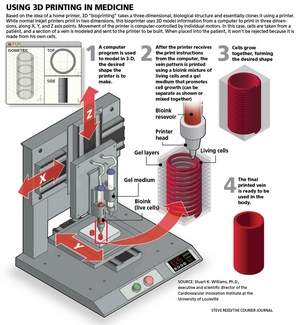Working Bioprinted Heart on the Horizon

Latest News
May 16, 2014
Earlier this year, engineers at the University of Louisville created a 3D printed heart model using flexible filament to help doctors at Kosair Children’s Hospital prepare to operate on the heart of a 14-month-old boy born with serious congenital heart defects. Based on CT scan images, the model (1.5 times the size of the actual heart) allowed the surgeons to plan and complete the surgery in just one operation.
Now researchers in the University’s Cardiovascular Innovation Institute are combining 3D printing and biology to create and print parts of an actual human heart using fat and collagen. A robotic six-axis printer uses the mixture of fat cells and collagen to print sections of heart. So far, the team has been able to recreate working pieces of heart muscle. Eventually, they could recreate the blood vessels and valves, and construct a complete organ using the University’s one-of-a-kind bioprinter.
3D printing has already shown promise in other medical applications. Nottingham Trent University researchers have developed an implantable, 3D-printed ventricular assist device (VAD) that could help patients waiting for heart transplants. On the bioprinting front, Utrecht Life Sciences has founded a Biofabrication Facility in The Netherlands. And researchers at Mount Sinai produced a bioprinted trachea using a membrane seeded with stem cells. The trachea was implanted in a baby pig.
Dr. Stuart Williams, chief of the Bioficial Heart program in Louisville, is also investigating the potential of printing pancreas, kidney and bone tissue. The lab has already created a human heart “patch” that could be used in patients as an alternative to traditional remedies.
While the group hopes to create a completely bioprinted, functioning human heart, Williams told TechRepublic that the ultimate goal would be to make a better heart.
“We are rethinking what the best design is for the heart and putting that into a computer,” Williams said. “What happens if we build a heart basically resistant to problems that can take place?”
You can see Williams explain 3D printed organs in the video below.
Source: TechRepublic
Subscribe to our FREE magazine, FREE email newsletters or both!
Latest News
About the Author
Brian Albright is the editorial director of Digital Engineering. Contact him at [email protected].
Follow DE





